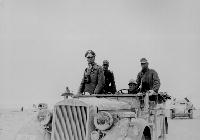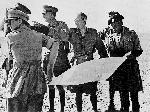The North African Campaign Of World War II



Click Above to go to Rommel's Page (LEFT) or Montgomery's Page (RIGHT)
Commanders and their Tactics In The Western Desert.
In literature on the North African Campaign in the Second World
War, both Rommel and Montgomery
as portrayed at tactical genius`s that turned
certain defeat into victory; this is due to the fact that history prefers to
glorify people and battles rather than an aspect of warfare such as supplies.
Rommel`s crowning glory is said to have been at Gazala in May 1942 and
Montgomery`s at El Alamein in October 1942, but
what is not mentioned is
startling similarity in their respective situations. In May 1942 Rommel had a
handsome numerical superiority in armour after receiving supplies that the
Allies had not detected, which contained the vastly superior Tiger and Panther
tanks (aswell as the Panzer Specials equipped with larger guns and thicker
face hardened and spaced armour) and enough fuel to launch a prolonged
offensive. Likewise in October 1942 Montgomery enjoyed a numerical
superiority that no other British commander had possessed in North Africa as
the Eighth army had received 300 sherman tanks
more capable of matching the
lower grade Panzer tanks and 100 self propelled
guns in time for the El Alamein
offensive, so from these statistics it is clear that logistical considerations
were much more decisive factors than Second World War literature cares to
mention.
One couldn`t help feeling a little sorry for the man
at this
time. He had shown himself a brilliant fighter in the desert; three times he
had escaped Montgomery`s efforts to surround his panzer army; he had been
consistently starved of supplies and equipment.1 Rommel was
constantly held
back by the lack of fuel and ammunition, which highlights the fact that
supplies
were a much more significant factor than commanders and their tactics. There is
also the fact that both strategies were very similar aswell. At Gazala Rommels
attack was “in accordance with the best German textbookstrategy2
and looking back on the battle of France, it all sounded rather
familiar3.
This was the case with Montgomery`s strategy too; where deception was to
play a key role and an attack was to be made in the suprise flank with the aim
of outflanking and encircling the enemy. This clearly shows that the tactics
employed at Gazala and El
Alamein although effective, were not original.
Rommel successfully attacked at Gazala, but then ignored Hitler and Cavallero`s
orders to pause, and pursued the retreating Eighth Army 250 miles accross the
desert to El Alamein. To put it bluntly, Rommel had over-stretched
himself4 and this was as much a failure as his Gazala
battle had been a
success, but again literature selectively excludes this in order to sustain the
popular image of Rommel as a tactical genious. Montgomery showed extreme
caution when pursuing the Axis forces after El Alamein, which he could afford
to do as his overwhelming numerical superiority neccesitated no hasty
pursuit and the forces from the Torch landings now
formed the 1st Army which was also advancing in the direction of Tunis.
Rommel was forced to go on the offensive at Alam
Halfa because he knew the advantage of numerical superiority would
soon lay in the hands of the Eighth Army. Fuel was in short supply and the
Afrika Corps had insufficient Air support and all these factors led to
Rommels defeat.
There is no disputing Rommels ability as both a tactician and a commander,
but his failure lay in his strategic thinking and the many problems he
faced with his supply situation and Hitlers disinterest in a
conflict of far reaching consequences. Montgomery too proved to be a
distinguished commander, whose tactics of precision planning, intensive
training and extreme caution utilized his vast numerical superiority to its
full potential. Again it is true that numerically, Montgomery was in a
very good position before El Alamein and this
has to be weighed against
the success of his strategy. The immmortalisation of these commanders in
popular history over-states their real contribution to the North African Desert
War. However, both Rommel and Montgomery executed their plans with such
success when they held the advantage, that they should indeed be seen as
Great Generals.
1 F.W Winterbotham, The Ultra Secret page 101
2 F.W Winterbotham, The Ultra Secret page 73
3 F.W Winterbotham, The Ultra Secret page 73
4 Peter Young, Purnells Encyclopedias Of The Second World War (Volume 3, page 892)
Supplies
Diverted and Committed Troops
Intelligence In North Africa
Weapons In North Africa
High Command Disputes And Interference
Concluding thoughts on the North African Campaign
Back to the Start
Mail Me



